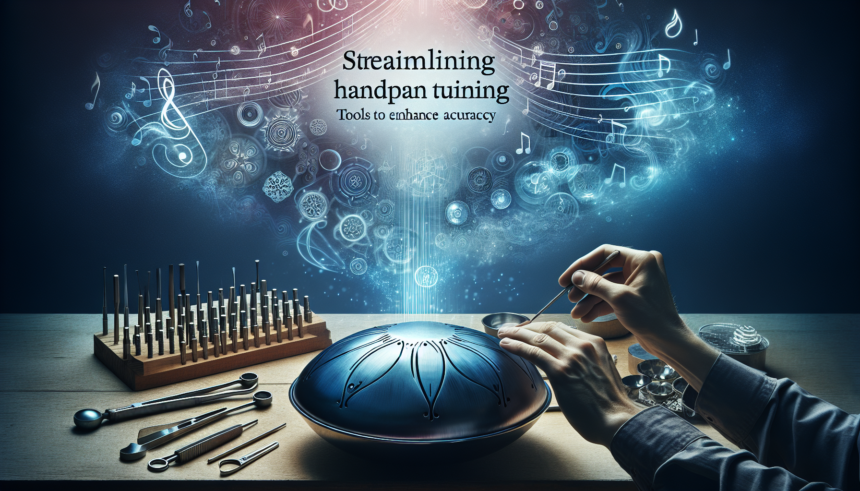The handpan, also known as a hang drum, is a captivating musical instrument that requires precise tuning to produce its mystical, resonant sounds. Tuning a handpan is both an art and a science, requiring a deep understanding of acoustics, a keen ear, and the right set of tools. This article explores the process of handpan tuning and the various tools used to enhance accuracy and streamline this intricate task.
Understanding Handpan Tuning
Handpans are steel instruments with a convex shape, featuring a central note surrounded by a circle of additional notes. Each note consists of a fundamental tone, an octave, and sometimes an overtone. The tuning process involves meticulously adjusting the metal to ensure each note sounds perfectly harmonious.
The Art of Tuning
Tuning a handpan is an artisanal skill often mastered over years of practice. The tuner carefully shapes the steel using hammers and other tools, listening attentively to identify minute discrepancies in pitch and harmonics. This process is highly sensitive to environmental variables such as temperature and humidity, which can affect the instrument’s sound.
While tuning by ear is a traditional method, technological advancements have introduced tools that aid in achieving greater precision and efficiency. These tools are increasingly essential as the demand for high-quality handpans grows.
Innovative Tools for Enhanced Accuracy
Several modern tools have emerged to assist handpan tuners, enabling them to achieve a higher degree of accuracy and consistency. Here, we’ll discuss some of the most effective tools that are revolutionizing handpan tuning.
1. Electronic Tuning Devices
Electronic tuners are indispensable tools in the handpan tuning process. These devices capture the sound waves produced by a note and display its frequency, allowing the tuner to make precise adjustments. Popular models include strobe tuners and digital tuners, which offer high sensitivity and accuracy. Using these devices, tuners can ensure each note meets the exact frequency specifications.
2. Spectrum Analyzers
Spectrum analyzers provide a visual representation of the sound’s frequency spectrum. By analyzing the harmonic content of each note, tuners can identify any overtones or frequencies that may need adjustment. This tool is particularly valuable for tuning the complex harmonic structures of handpans, ensuring that each note’s fundamental tone and harmonics are perfectly aligned.
3. Contact Microphones
Contact microphones, also known as piezo pickups, are used to capture the vibrations of the handpan directly from the metal surface. These microphones are attached to the instrument, allowing the tuner to isolate and analyze the sound of individual notes without interference from ambient noise. This precise feedback is crucial for fine-tuning the handpan in noisy environments.
4. Hammering Tools
The selection of hammers used in handpan tuning is critical. Tuners typically employ a variety of hammer shapes and weights to achieve different effects on the metal. Precision hammers, often made of specialized materials like brass or stainless steel, allow for controlled impacts that delicately adjust the pitch and timbre of each note. The use of ergonomic hammer handles also helps reduce the physical strain on the tuner during long tuning sessions.
5. Tuning Software
Tuning software programs are becoming increasingly popular among handpan tuners. These programs often include features such as frequency analysis, harmonic visualization, and tuning templates specific to different handpan scales. By integrating these tools with electronic tuners and microphones, tuners can achieve precise and repeatable tuning results. Some software also offers the ability to store and recall tuning presets, making it easier to retune instruments to their original specifications.
Streamlining the Tuning Workflow
In addition to individual tools, many tuners adopt specific workflows and best practices to streamline the tuning process. Here are some strategies commonly used to enhance efficiency and accuracy.
1. Pre-Tuning and Rough Tuning
Pre-tuning involves roughing out the initial shapes and pitches of the notes before fine-tuning. This step helps stabilize the instrument and makes the fine-tuning process more efficient. By using electronic tuners and spectrum analyzers during pre-tuning, tuners can quickly bring the notes close to their target frequencies.
2. Incremental Adjustments
Making small, incremental adjustments allows tuners to methodically refine each note without overshooting the desired pitch. This approach minimizes the risk of introducing new inaccuracies while correcting existing ones. Spectrum analyzers and contact microphones provide real-time feedback, helping tuners make precise adjustments with each hammer strike.
3. Environmental Control
Maintaining a consistent environment during the tuning process is crucial for achieving accurate results. Tuners often work in controlled environments where temperature and humidity are regulated. This practice ensures that the metal remains stable and reduces the likelihood of pitch fluctuations caused by environmental changes.
4. Using Reference Instruments
Using a reference instrument, such as a perfectly tuned handpan or a tuning fork, helps tuners verify the accuracy of their adjustments. Comparing the sounds of the handpan being tuned to the reference instrument provides an additional layer of precision, ensuring each note matches the desired pitch.
5. Continuous Learning and Adaptation
The field of handpan tuning is constantly evolving, with new techniques and tools emerging regularly. Tuners who stay updated with the latest developments and continuously refine their skills are better equipped to achieve optimum results. Participating in workshops, forums, and collaborations with other tuners fosters a culture of continuous improvement and innovation.
Conclusion
Handpan tuning is a meticulous and highly skilled process that combines traditional craftsmanship with modern technology. The use of electronic tuning devices, spectrum analyzers, contact microphones, specialized hammering tools, and tuning software significantly enhances the accuracy and efficiency of the tuning process. By adopting best practices and maintaining a commitment to continuous learning, tuners can achieve exceptional results, producing handpans with beautifully resonant and harmonically balanced sounds. As the demand for high-quality handpans continues to grow, the integration of these innovative tools and techniques will remain essential for meeting the expectations of discerning musicians and enthusiasts.
FAQs
1. What is the most challenging aspect of handpan tuning?
The most challenging aspect of handpan tuning is achieving perfect harmony among all the notes. Given the complex interplay of fundamental tones, octaves, and overtones, even minor discrepancies can affect the overall sound quality. Additionally, environmental factors like temperature and humidity can further complicate the process, requiring tuners to adapt quickly.
2. How often should a handpan be retuned?
The frequency of retuning depends on various factors, including how often the instrument is played and the conditions in which it is stored. Generally, a well-tuned handpan can retain its tuning for years, but regular check-ups by a professional tuner are recommended to maintain optimal sound quality.
3. Can I tune my handpan at home?
Tuning a handpan requires specialized skills and tools, making it a challenging task for those without proper training. While basic maintenance, like minor pitch adjustments, can sometimes be done at home, it is usually best to leave the full tuning process to experienced professionals to ensure the highest quality sound.
4. How do electronic tuners work?
Electronic tuners work by detecting the frequency of the sound waves produced by a note and displaying the corresponding pitch. This allows the tuner to see how close the note is to its target frequency and make precise adjustments. Advanced electronic tuners can also analyze harmonics, providing a comprehensive view of the note’s tonal structure.
5. What is the role of spectrum analyzers in handpan tuning?
Spectrum analyzers provide a visual representation of the frequency spectrum of each note. By revealing the harmonic content, these tools help tuners identify and correct any inconsistencies in the overtone series. This visual feedback is crucial for achieving a perfectly balanced and harmonically rich sound.





